HNN108: Research Evidence Annotation and Clinical Nursing Practice
VerifiedAdded on 2023/06/09
|16
|3417
|365
Report
AI Summary
This report analyzes two peer-reviewed articles concerning symptom management in palliative and end-of-life care. The first article focuses on the CAREFuL program, a comprehensive intervention implemented in Belgian hospitals to improve the comfort of dying patients in geriatric wards. It employed a quantitative approach, comparing intervention and control groups to assess the program's impact on patient comfort, as measured by nurse and family caregiver assessments. The second article explores patient, relative, and clinician perspectives on symptom management in the UK, utilizing a qualitative study design with semi-structured questionnaires to gather data on issues like nutrition, hydration, and pain. The findings highlight the importance of effective symptom management, the need for more research, and the role of communication and the care environment in enhancing patient comfort. The report emphasizes the need for improved symptom management, the role of research and clinical guidelines, and the importance of patient-centered care in palliative settings. The report summarizes the research methodology, findings, and implications for nursing practice, including the application of evidence-based interventions to improve patient outcomes and reduce distress.
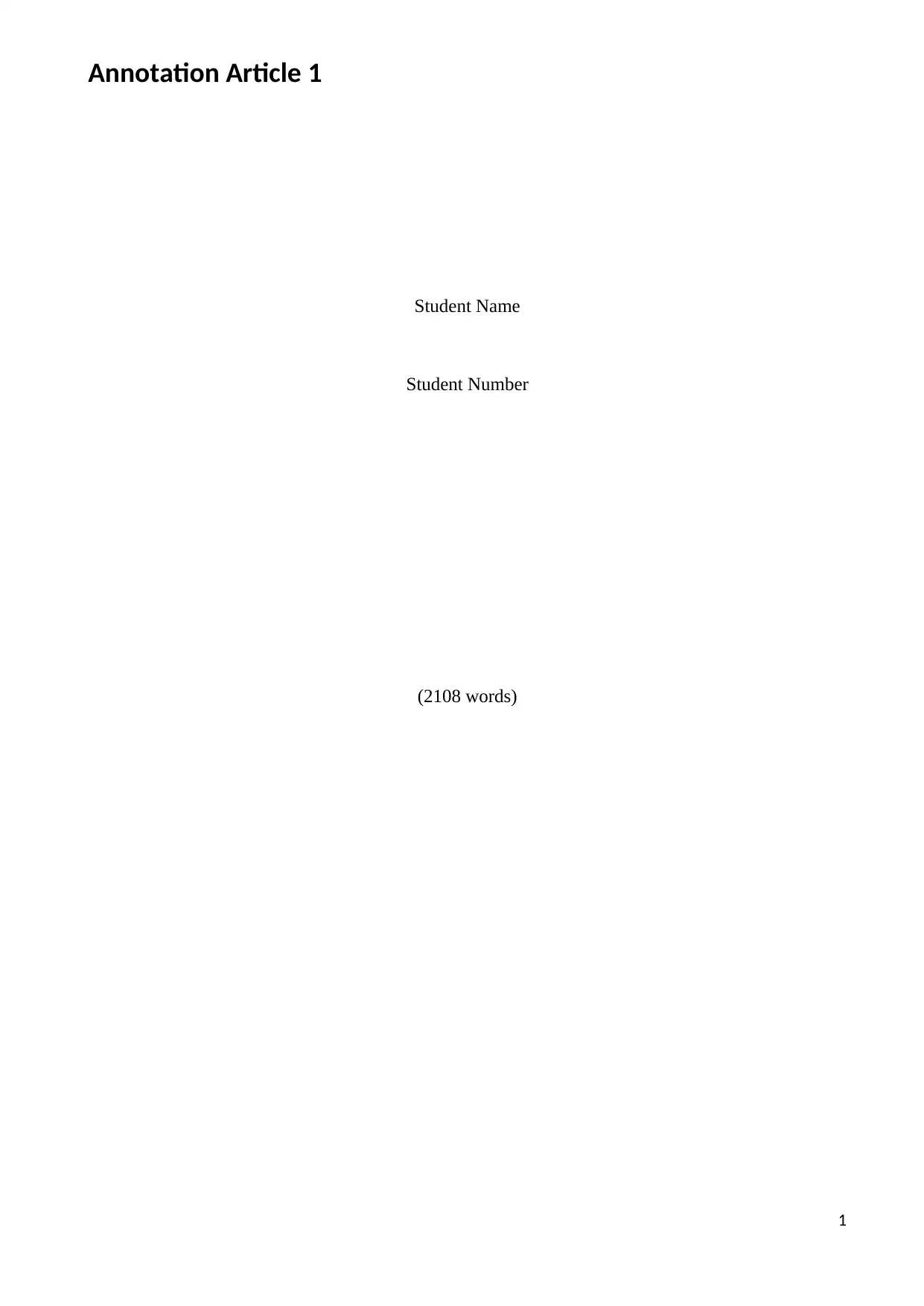
Annotation Article 1
Student Name
Student Number
(2108 words)
1
Student Name
Student Number
(2108 words)
1
Paraphrase This Document
Need a fresh take? Get an instant paraphrase of this document with our AI Paraphraser
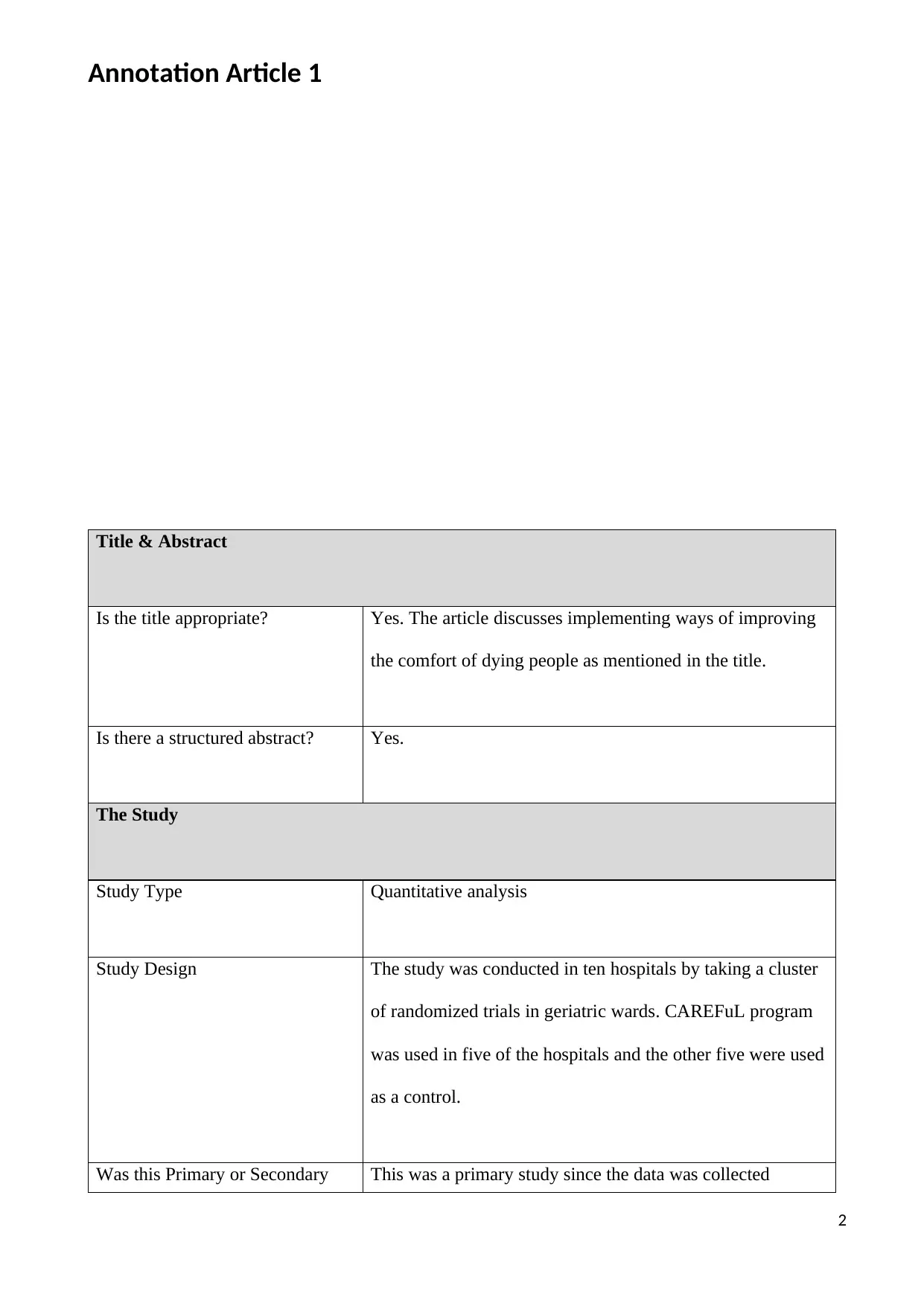
Annotation Article 1
Title & Abstract
Is the title appropriate? Yes. The article discusses implementing ways of improving
the comfort of dying people as mentioned in the title.
Is there a structured abstract? Yes.
The Study
Study Type Quantitative analysis
Study Design The study was conducted in ten hospitals by taking a cluster
of randomized trials in geriatric wards. CAREFuL program
was used in five of the hospitals and the other five were used
as a control.
Was this Primary or Secondary This was a primary study since the data was collected
2
Title & Abstract
Is the title appropriate? Yes. The article discusses implementing ways of improving
the comfort of dying people as mentioned in the title.
Is there a structured abstract? Yes.
The Study
Study Type Quantitative analysis
Study Design The study was conducted in ten hospitals by taking a cluster
of randomized trials in geriatric wards. CAREFuL program
was used in five of the hospitals and the other five were used
as a control.
Was this Primary or Secondary This was a primary study since the data was collected
2
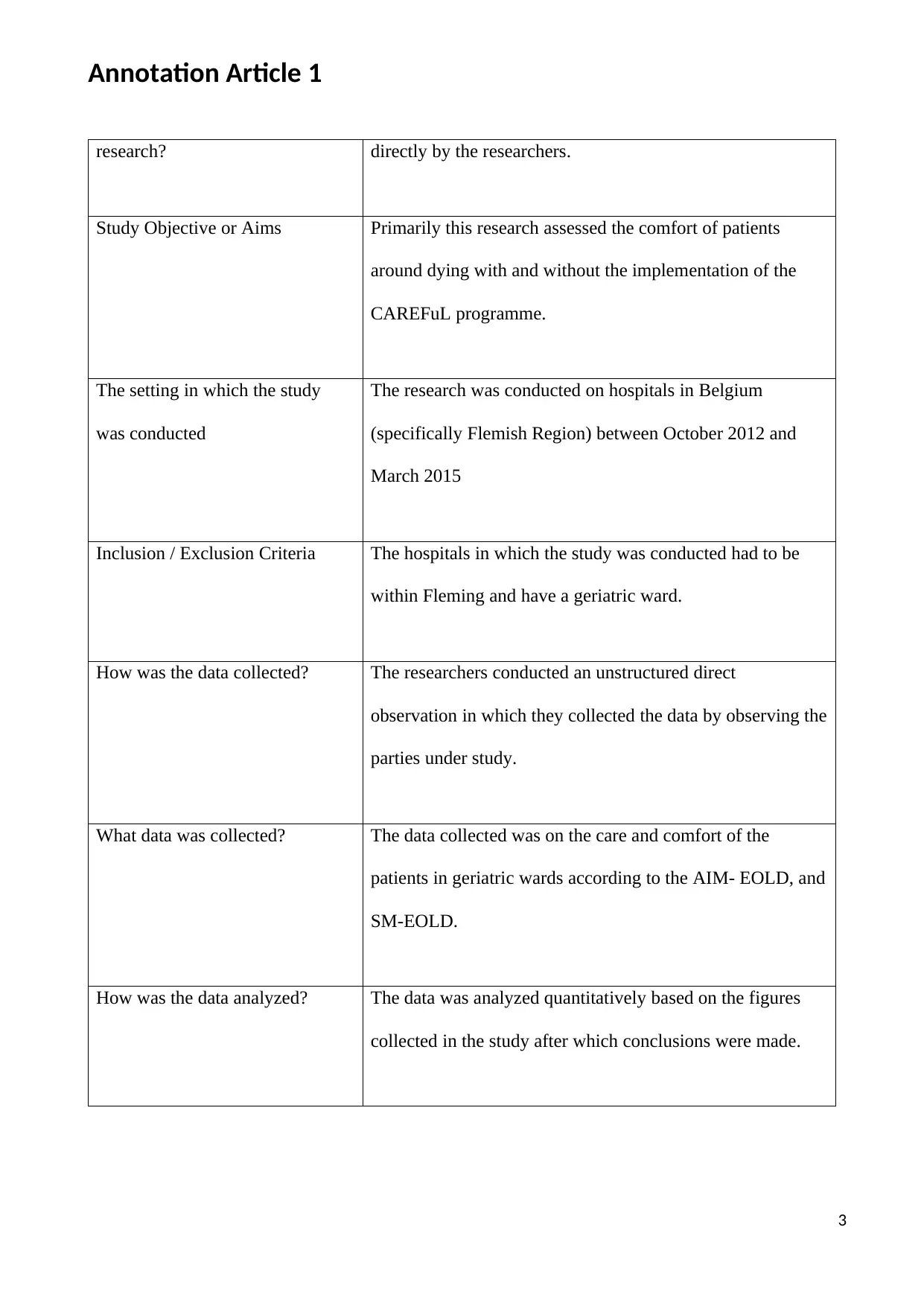
Annotation Article 1
research? directly by the researchers.
Study Objective or Aims Primarily this research assessed the comfort of patients
around dying with and without the implementation of the
CAREFuL programme.
The setting in which the study
was conducted
The research was conducted on hospitals in Belgium
(specifically Flemish Region) between October 2012 and
March 2015
Inclusion / Exclusion Criteria The hospitals in which the study was conducted had to be
within Fleming and have a geriatric ward.
How was the data collected? The researchers conducted an unstructured direct
observation in which they collected the data by observing the
parties under study.
What data was collected? The data collected was on the care and comfort of the
patients in geriatric wards according to the AIM- EOLD, and
SM-EOLD.
How was the data analyzed? The data was analyzed quantitatively based on the figures
collected in the study after which conclusions were made.
3
research? directly by the researchers.
Study Objective or Aims Primarily this research assessed the comfort of patients
around dying with and without the implementation of the
CAREFuL programme.
The setting in which the study
was conducted
The research was conducted on hospitals in Belgium
(specifically Flemish Region) between October 2012 and
March 2015
Inclusion / Exclusion Criteria The hospitals in which the study was conducted had to be
within Fleming and have a geriatric ward.
How was the data collected? The researchers conducted an unstructured direct
observation in which they collected the data by observing the
parties under study.
What data was collected? The data collected was on the care and comfort of the
patients in geriatric wards according to the AIM- EOLD, and
SM-EOLD.
How was the data analyzed? The data was analyzed quantitatively based on the figures
collected in the study after which conclusions were made.
3
⊘ This is a preview!⊘
Do you want full access?
Subscribe today to unlock all pages.

Trusted by 1+ million students worldwide
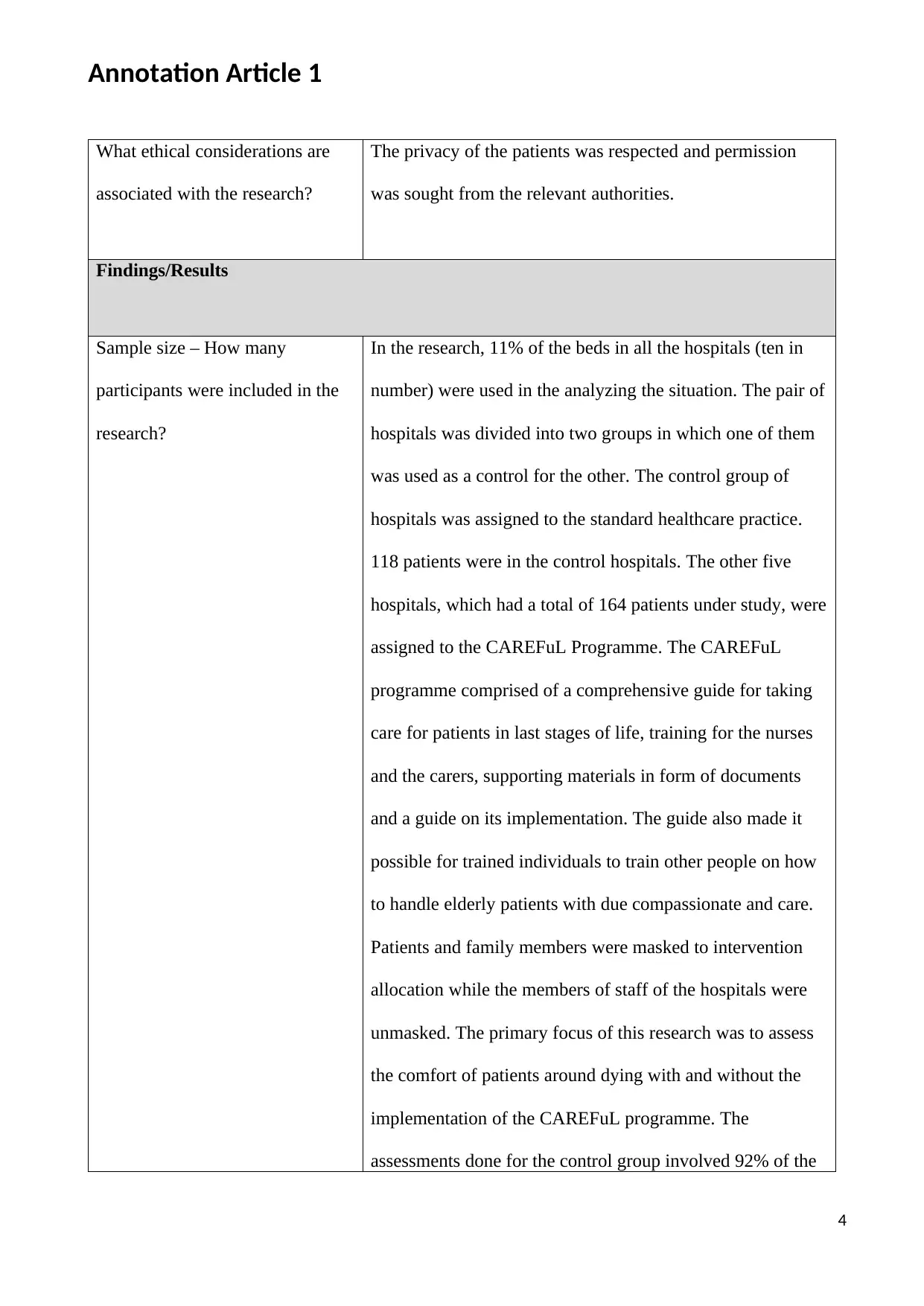
Annotation Article 1
What ethical considerations are
associated with the research?
The privacy of the patients was respected and permission
was sought from the relevant authorities.
Findings/Results
Sample size – How many
participants were included in the
research?
In the research, 11% of the beds in all the hospitals (ten in
number) were used in the analyzing the situation. The pair of
hospitals was divided into two groups in which one of them
was used as a control for the other. The control group of
hospitals was assigned to the standard healthcare practice.
118 patients were in the control hospitals. The other five
hospitals, which had a total of 164 patients under study, were
assigned to the CAREFuL Programme. The CAREFuL
programme comprised of a comprehensive guide for taking
care for patients in last stages of life, training for the nurses
and the carers, supporting materials in form of documents
and a guide on its implementation. The guide also made it
possible for trained individuals to train other people on how
to handle elderly patients with due compassionate and care.
Patients and family members were masked to intervention
allocation while the members of staff of the hospitals were
unmasked. The primary focus of this research was to assess
the comfort of patients around dying with and without the
implementation of the CAREFuL programme. The
assessments done for the control group involved 92% of the
4
What ethical considerations are
associated with the research?
The privacy of the patients was respected and permission
was sought from the relevant authorities.
Findings/Results
Sample size – How many
participants were included in the
research?
In the research, 11% of the beds in all the hospitals (ten in
number) were used in the analyzing the situation. The pair of
hospitals was divided into two groups in which one of them
was used as a control for the other. The control group of
hospitals was assigned to the standard healthcare practice.
118 patients were in the control hospitals. The other five
hospitals, which had a total of 164 patients under study, were
assigned to the CAREFuL Programme. The CAREFuL
programme comprised of a comprehensive guide for taking
care for patients in last stages of life, training for the nurses
and the carers, supporting materials in form of documents
and a guide on its implementation. The guide also made it
possible for trained individuals to train other people on how
to handle elderly patients with due compassionate and care.
Patients and family members were masked to intervention
allocation while the members of staff of the hospitals were
unmasked. The primary focus of this research was to assess
the comfort of patients around dying with and without the
implementation of the CAREFuL programme. The
assessments done for the control group involved 92% of the
4
Paraphrase This Document
Need a fresh take? Get an instant paraphrase of this document with our AI Paraphraser
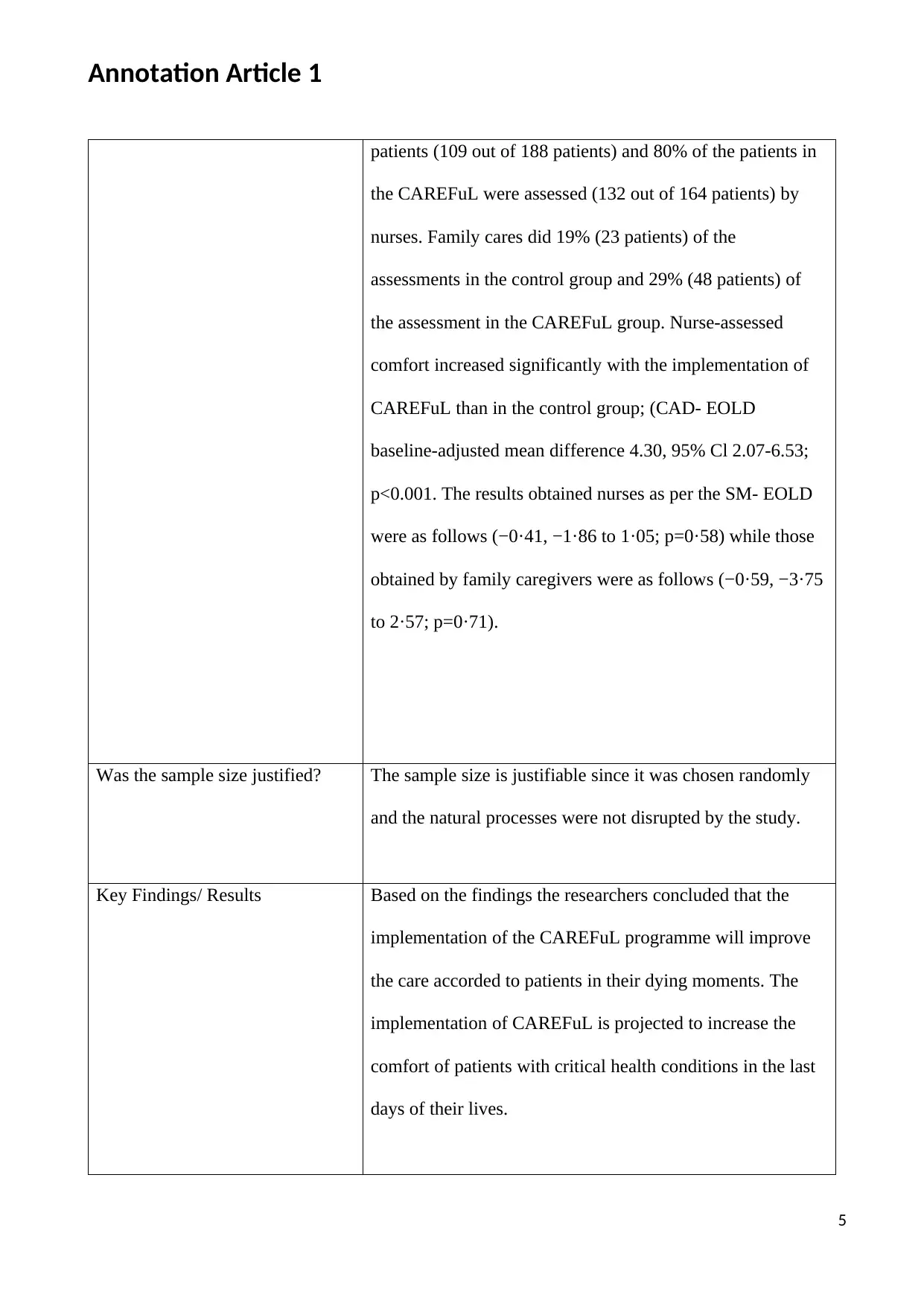
Annotation Article 1
patients (109 out of 188 patients) and 80% of the patients in
the CAREFuL were assessed (132 out of 164 patients) by
nurses. Family cares did 19% (23 patients) of the
assessments in the control group and 29% (48 patients) of
the assessment in the CAREFuL group. Nurse-assessed
comfort increased significantly with the implementation of
CAREFuL than in the control group; (CAD- EOLD
baseline-adjusted mean difference 4.30, 95% Cl 2.07-6.53;
p<0.001. The results obtained nurses as per the SM- EOLD
were as follows (−0·41, −1·86 to 1·05; p=0·58) while those
obtained by family caregivers were as follows (−0·59, −3·75
to 2·57; p=0·71).
Was the sample size justified? The sample size is justifiable since it was chosen randomly
and the natural processes were not disrupted by the study.
Key Findings/ Results Based on the findings the researchers concluded that the
implementation of the CAREFuL programme will improve
the care accorded to patients in their dying moments. The
implementation of CAREFuL is projected to increase the
comfort of patients with critical health conditions in the last
days of their lives.
5
patients (109 out of 188 patients) and 80% of the patients in
the CAREFuL were assessed (132 out of 164 patients) by
nurses. Family cares did 19% (23 patients) of the
assessments in the control group and 29% (48 patients) of
the assessment in the CAREFuL group. Nurse-assessed
comfort increased significantly with the implementation of
CAREFuL than in the control group; (CAD- EOLD
baseline-adjusted mean difference 4.30, 95% Cl 2.07-6.53;
p<0.001. The results obtained nurses as per the SM- EOLD
were as follows (−0·41, −1·86 to 1·05; p=0·58) while those
obtained by family caregivers were as follows (−0·59, −3·75
to 2·57; p=0·71).
Was the sample size justified? The sample size is justifiable since it was chosen randomly
and the natural processes were not disrupted by the study.
Key Findings/ Results Based on the findings the researchers concluded that the
implementation of the CAREFuL programme will improve
the care accorded to patients in their dying moments. The
implementation of CAREFuL is projected to increase the
comfort of patients with critical health conditions in the last
days of their lives.
5

Annotation Article 1
6
6
⊘ This is a preview!⊘
Do you want full access?
Subscribe today to unlock all pages.

Trusted by 1+ million students worldwide
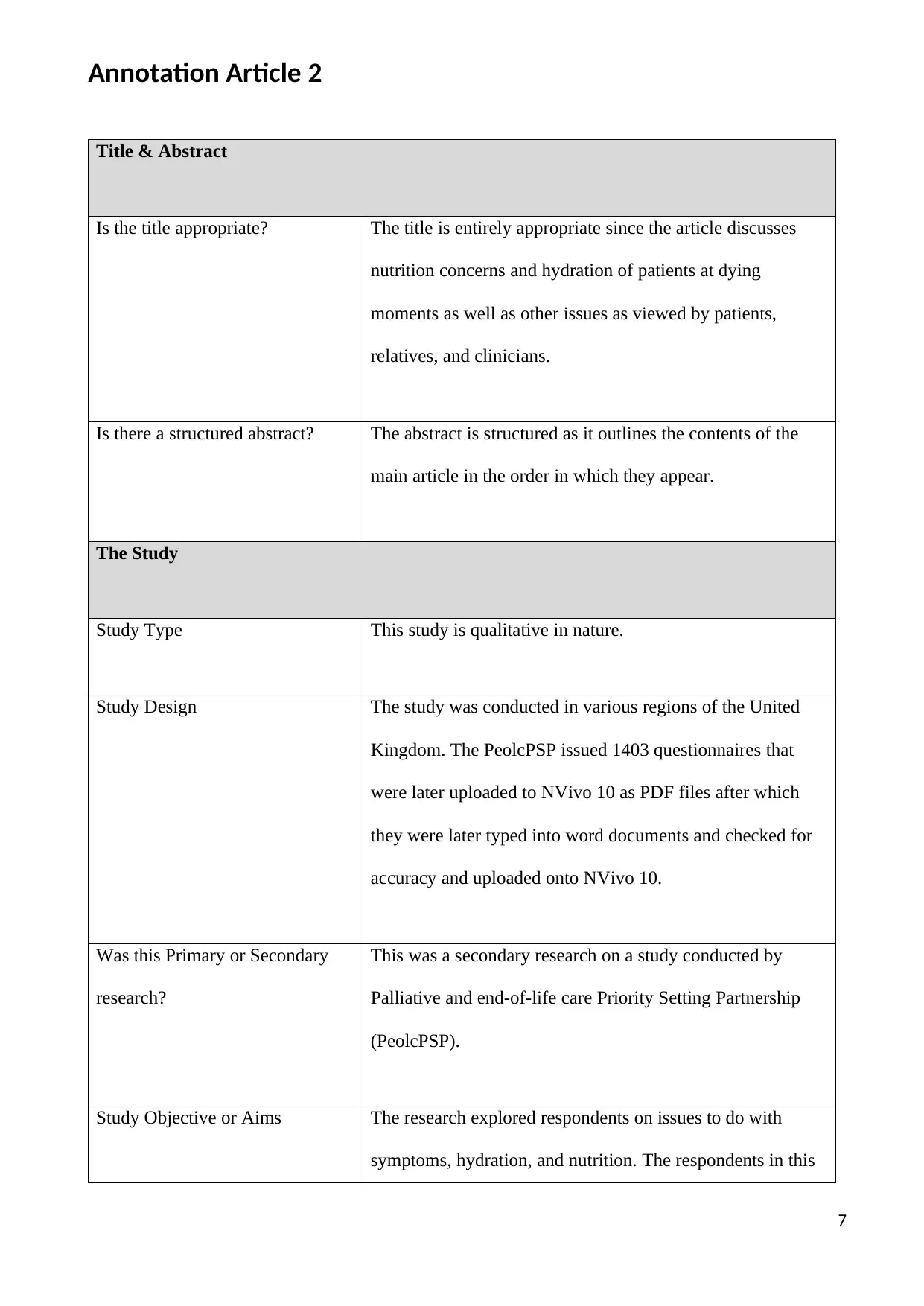
Annotation Article 2
Title & Abstract
Is the title appropriate? The title is entirely appropriate since the article discusses
nutrition concerns and hydration of patients at dying
moments as well as other issues as viewed by patients,
relatives, and clinicians.
Is there a structured abstract? The abstract is structured as it outlines the contents of the
main article in the order in which they appear.
The Study
Study Type This study is qualitative in nature.
Study Design The study was conducted in various regions of the United
Kingdom. The PeolcPSP issued 1403 questionnaires that
were later uploaded to NVivo 10 as PDF files after which
they were later typed into word documents and checked for
accuracy and uploaded onto NVivo 10.
Was this Primary or Secondary
research?
This was a secondary research on a study conducted by
Palliative and end-of-life care Priority Setting Partnership
(PeolcPSP).
Study Objective or Aims The research explored respondents on issues to do with
symptoms, hydration, and nutrition. The respondents in this
7
Title & Abstract
Is the title appropriate? The title is entirely appropriate since the article discusses
nutrition concerns and hydration of patients at dying
moments as well as other issues as viewed by patients,
relatives, and clinicians.
Is there a structured abstract? The abstract is structured as it outlines the contents of the
main article in the order in which they appear.
The Study
Study Type This study is qualitative in nature.
Study Design The study was conducted in various regions of the United
Kingdom. The PeolcPSP issued 1403 questionnaires that
were later uploaded to NVivo 10 as PDF files after which
they were later typed into word documents and checked for
accuracy and uploaded onto NVivo 10.
Was this Primary or Secondary
research?
This was a secondary research on a study conducted by
Palliative and end-of-life care Priority Setting Partnership
(PeolcPSP).
Study Objective or Aims The research explored respondents on issues to do with
symptoms, hydration, and nutrition. The respondents in this
7
Paraphrase This Document
Need a fresh take? Get an instant paraphrase of this document with our AI Paraphraser
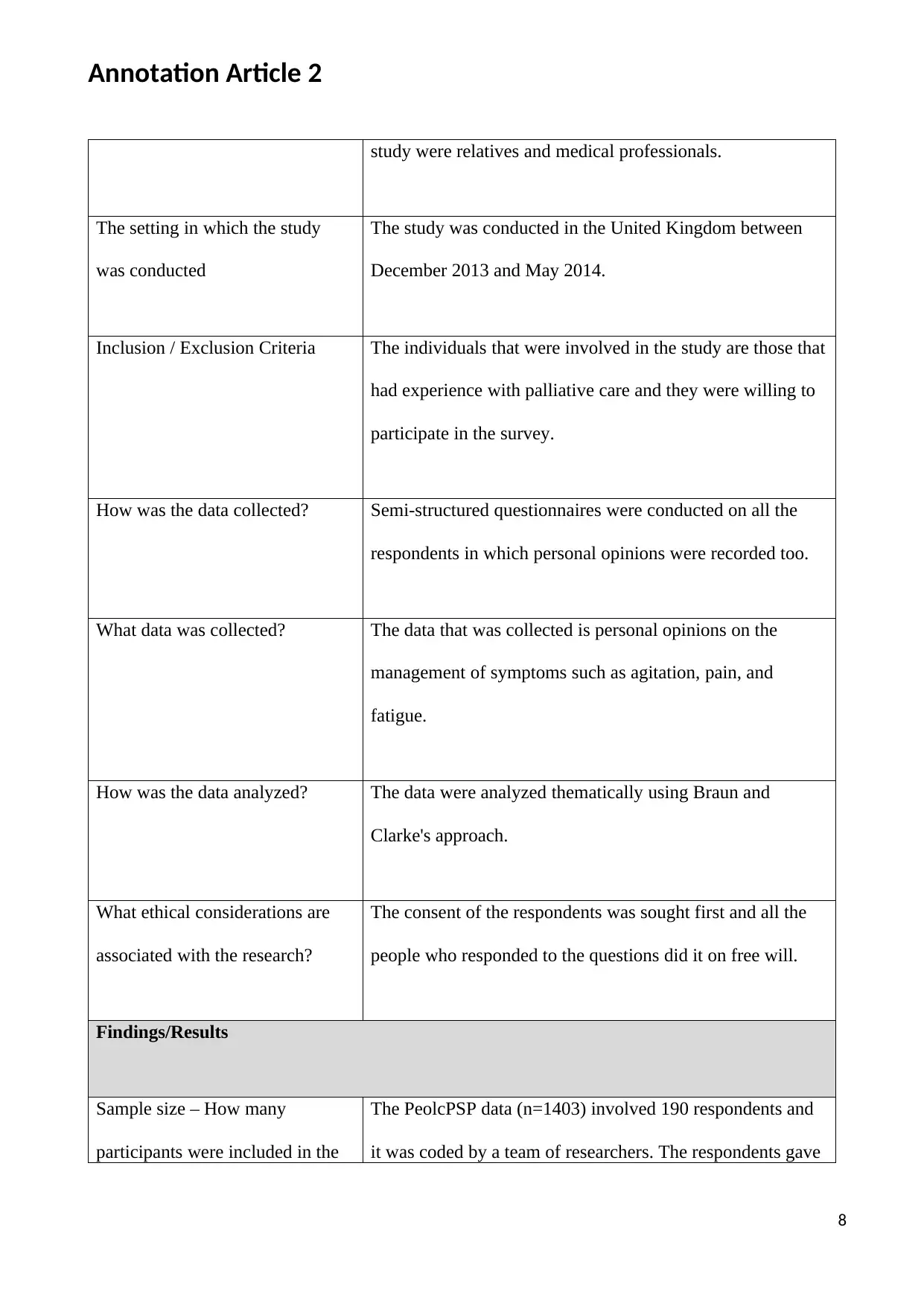
Annotation Article 2
study were relatives and medical professionals.
The setting in which the study
was conducted
The study was conducted in the United Kingdom between
December 2013 and May 2014.
Inclusion / Exclusion Criteria The individuals that were involved in the study are those that
had experience with palliative care and they were willing to
participate in the survey.
How was the data collected? Semi-structured questionnaires were conducted on all the
respondents in which personal opinions were recorded too.
What data was collected? The data that was collected is personal opinions on the
management of symptoms such as agitation, pain, and
fatigue.
How was the data analyzed? The data were analyzed thematically using Braun and
Clarke's approach.
What ethical considerations are
associated with the research?
The consent of the respondents was sought first and all the
people who responded to the questions did it on free will.
Findings/Results
Sample size – How many
participants were included in the
The PeolcPSP data (n=1403) involved 190 respondents and
it was coded by a team of researchers. The respondents gave
8
study were relatives and medical professionals.
The setting in which the study
was conducted
The study was conducted in the United Kingdom between
December 2013 and May 2014.
Inclusion / Exclusion Criteria The individuals that were involved in the study are those that
had experience with palliative care and they were willing to
participate in the survey.
How was the data collected? Semi-structured questionnaires were conducted on all the
respondents in which personal opinions were recorded too.
What data was collected? The data that was collected is personal opinions on the
management of symptoms such as agitation, pain, and
fatigue.
How was the data analyzed? The data were analyzed thematically using Braun and
Clarke's approach.
What ethical considerations are
associated with the research?
The consent of the respondents was sought first and all the
people who responded to the questions did it on free will.
Findings/Results
Sample size – How many
participants were included in the
The PeolcPSP data (n=1403) involved 190 respondents and
it was coded by a team of researchers. The respondents gave
8
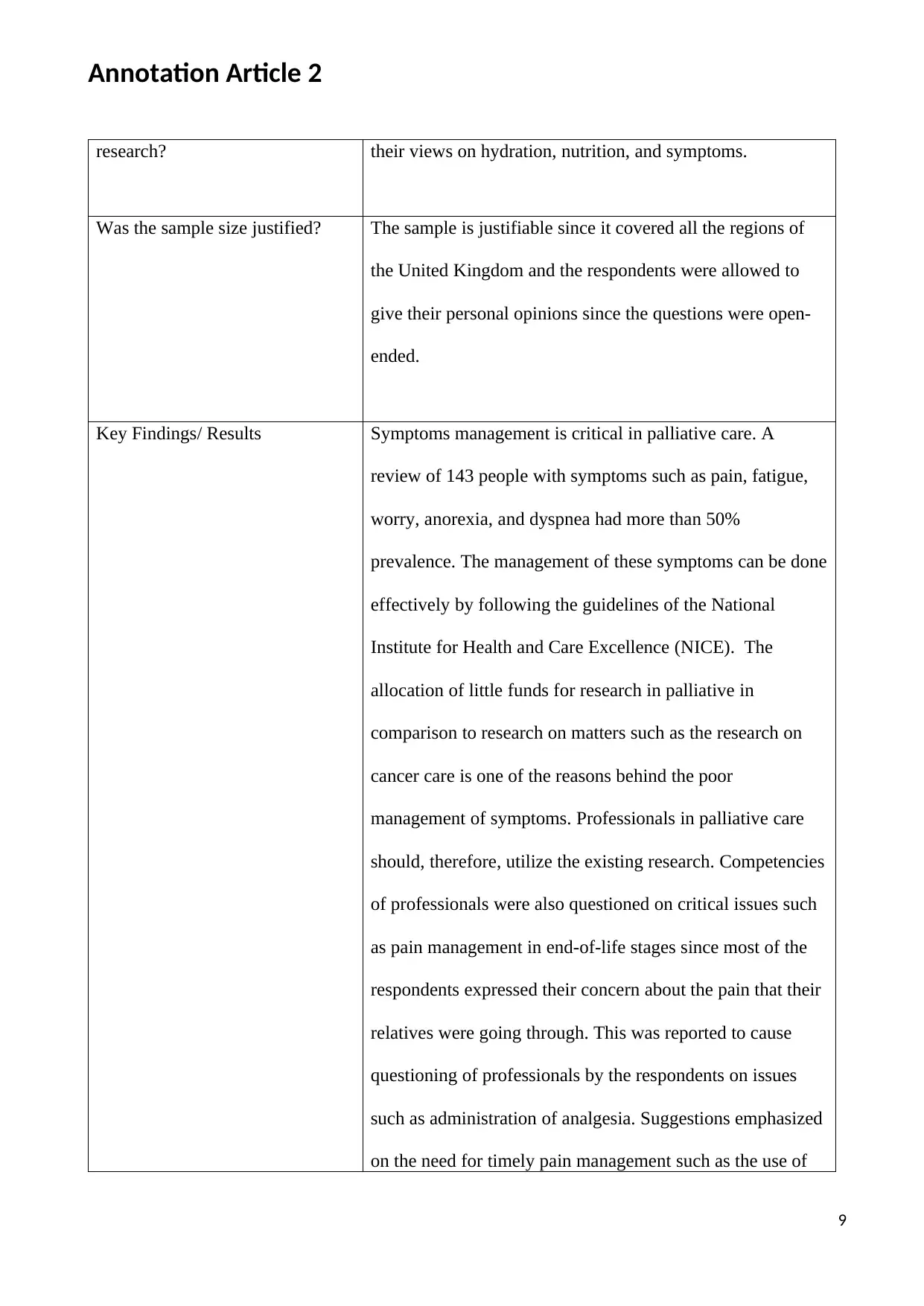
Annotation Article 2
research? their views on hydration, nutrition, and symptoms.
Was the sample size justified? The sample is justifiable since it covered all the regions of
the United Kingdom and the respondents were allowed to
give their personal opinions since the questions were open-
ended.
Key Findings/ Results Symptoms management is critical in palliative care. A
review of 143 people with symptoms such as pain, fatigue,
worry, anorexia, and dyspnea had more than 50%
prevalence. The management of these symptoms can be done
effectively by following the guidelines of the National
Institute for Health and Care Excellence (NICE). The
allocation of little funds for research in palliative in
comparison to research on matters such as the research on
cancer care is one of the reasons behind the poor
management of symptoms. Professionals in palliative care
should, therefore, utilize the existing research. Competencies
of professionals were also questioned on critical issues such
as pain management in end-of-life stages since most of the
respondents expressed their concern about the pain that their
relatives were going through. This was reported to cause
questioning of professionals by the respondents on issues
such as administration of analgesia. Suggestions emphasized
on the need for timely pain management such as the use of
9
research? their views on hydration, nutrition, and symptoms.
Was the sample size justified? The sample is justifiable since it covered all the regions of
the United Kingdom and the respondents were allowed to
give their personal opinions since the questions were open-
ended.
Key Findings/ Results Symptoms management is critical in palliative care. A
review of 143 people with symptoms such as pain, fatigue,
worry, anorexia, and dyspnea had more than 50%
prevalence. The management of these symptoms can be done
effectively by following the guidelines of the National
Institute for Health and Care Excellence (NICE). The
allocation of little funds for research in palliative in
comparison to research on matters such as the research on
cancer care is one of the reasons behind the poor
management of symptoms. Professionals in palliative care
should, therefore, utilize the existing research. Competencies
of professionals were also questioned on critical issues such
as pain management in end-of-life stages since most of the
respondents expressed their concern about the pain that their
relatives were going through. This was reported to cause
questioning of professionals by the respondents on issues
such as administration of analgesia. Suggestions emphasized
on the need for timely pain management such as the use of
9
⊘ This is a preview!⊘
Do you want full access?
Subscribe today to unlock all pages.

Trusted by 1+ million students worldwide
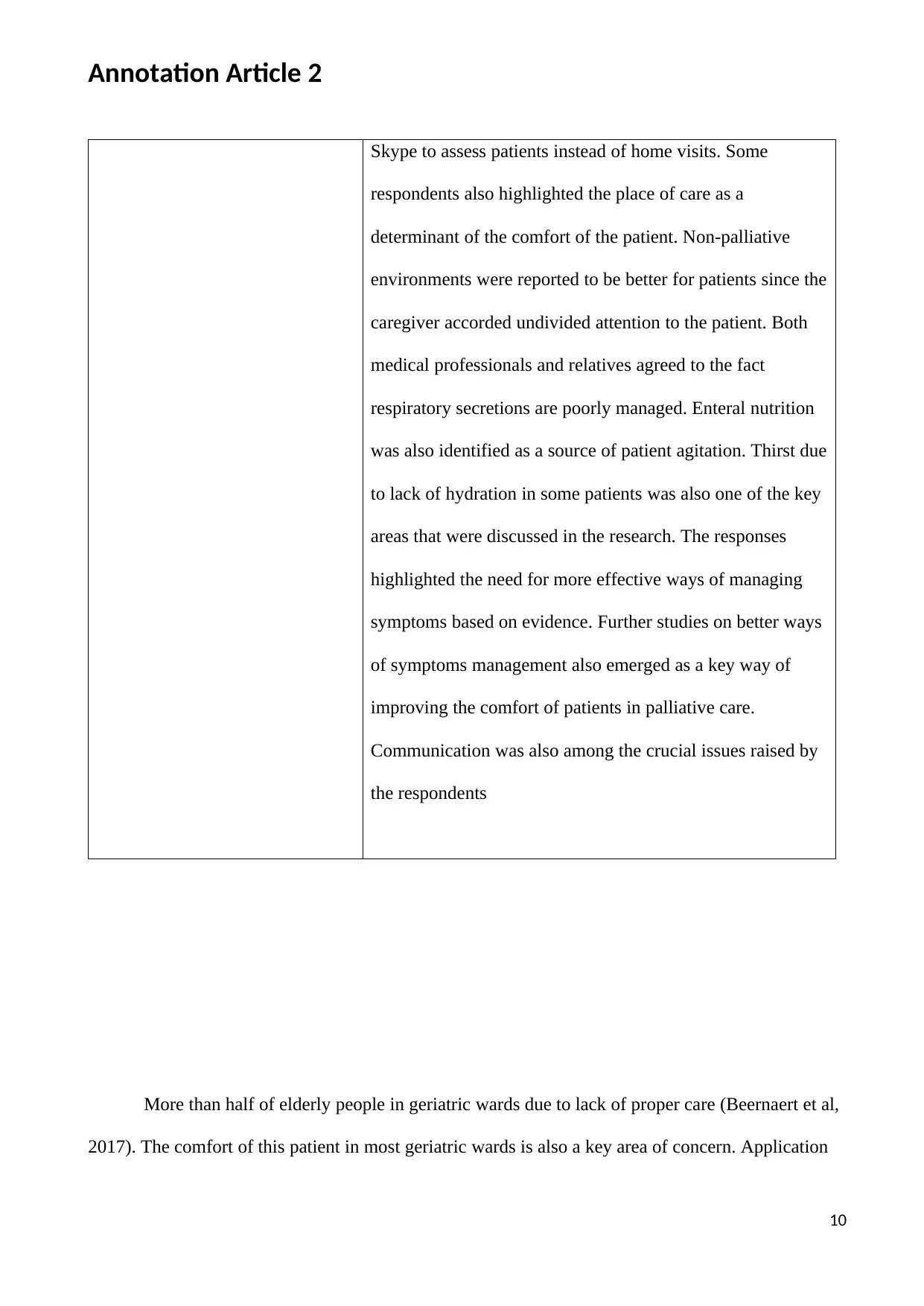
Annotation Article 2
Skype to assess patients instead of home visits. Some
respondents also highlighted the place of care as a
determinant of the comfort of the patient. Non-palliative
environments were reported to be better for patients since the
caregiver accorded undivided attention to the patient. Both
medical professionals and relatives agreed to the fact
respiratory secretions are poorly managed. Enteral nutrition
was also identified as a source of patient agitation. Thirst due
to lack of hydration in some patients was also one of the key
areas that were discussed in the research. The responses
highlighted the need for more effective ways of managing
symptoms based on evidence. Further studies on better ways
of symptoms management also emerged as a key way of
improving the comfort of patients in palliative care.
Communication was also among the crucial issues raised by
the respondents
More than half of elderly people in geriatric wards due to lack of proper care (Beernaert et al,
2017). The comfort of this patient in most geriatric wards is also a key area of concern. Application
10
Skype to assess patients instead of home visits. Some
respondents also highlighted the place of care as a
determinant of the comfort of the patient. Non-palliative
environments were reported to be better for patients since the
caregiver accorded undivided attention to the patient. Both
medical professionals and relatives agreed to the fact
respiratory secretions are poorly managed. Enteral nutrition
was also identified as a source of patient agitation. Thirst due
to lack of hydration in some patients was also one of the key
areas that were discussed in the research. The responses
highlighted the need for more effective ways of managing
symptoms based on evidence. Further studies on better ways
of symptoms management also emerged as a key way of
improving the comfort of patients in palliative care.
Communication was also among the crucial issues raised by
the respondents
More than half of elderly people in geriatric wards due to lack of proper care (Beernaert et al,
2017). The comfort of this patient in most geriatric wards is also a key area of concern. Application
10
Paraphrase This Document
Need a fresh take? Get an instant paraphrase of this document with our AI Paraphraser
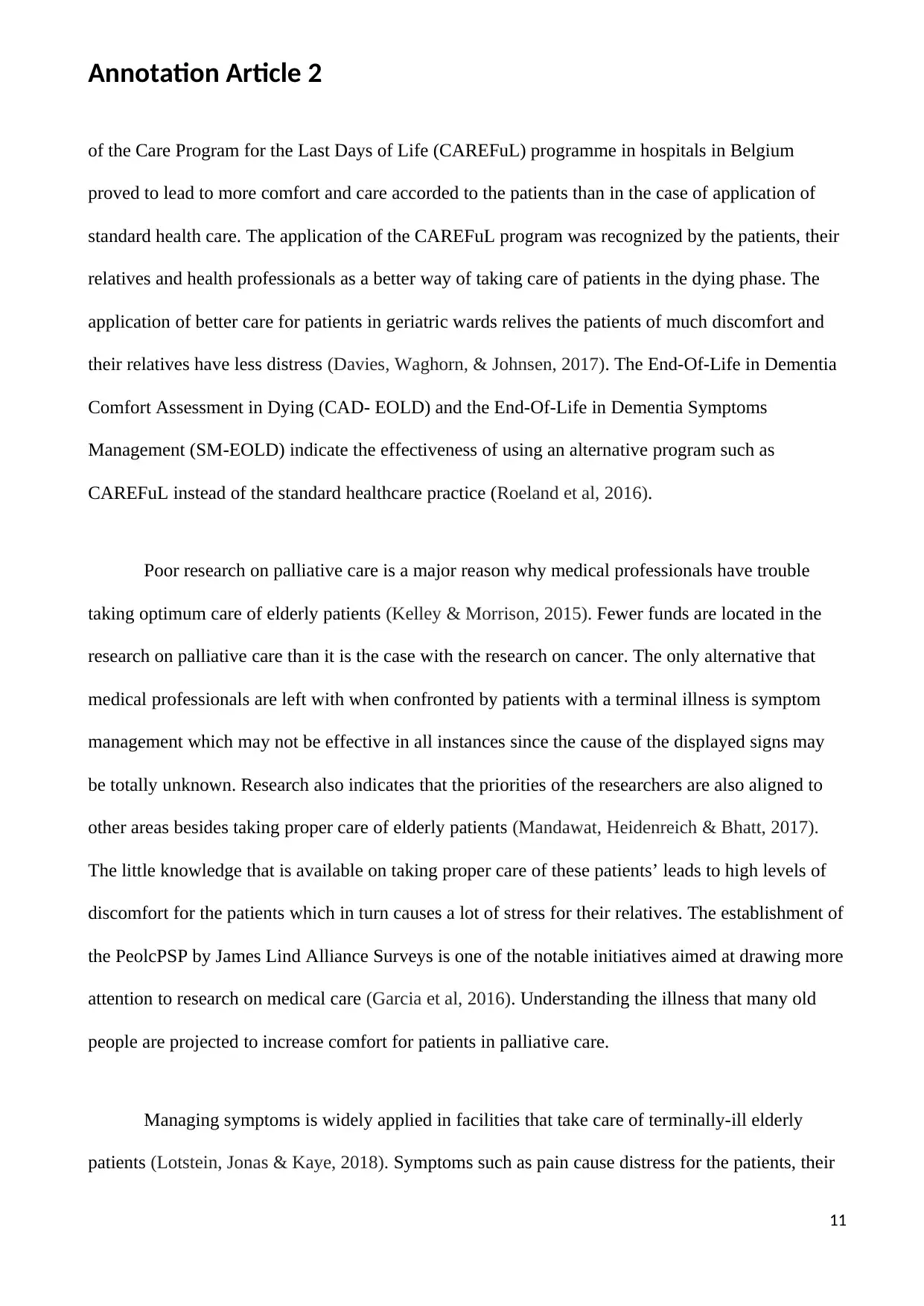
Annotation Article 2
of the Care Program for the Last Days of Life (CAREFuL) programme in hospitals in Belgium
proved to lead to more comfort and care accorded to the patients than in the case of application of
standard health care. The application of the CAREFuL program was recognized by the patients, their
relatives and health professionals as a better way of taking care of patients in the dying phase. The
application of better care for patients in geriatric wards relives the patients of much discomfort and
their relatives have less distress (Davies, Waghorn, & Johnsen, 2017). The End-Of-Life in Dementia
Comfort Assessment in Dying (CAD- EOLD) and the End-Of-Life in Dementia Symptoms
Management (SM-EOLD) indicate the effectiveness of using an alternative program such as
CAREFuL instead of the standard healthcare practice (Roeland et al, 2016).
Poor research on palliative care is a major reason why medical professionals have trouble
taking optimum care of elderly patients (Kelley & Morrison, 2015). Fewer funds are located in the
research on palliative care than it is the case with the research on cancer. The only alternative that
medical professionals are left with when confronted by patients with a terminal illness is symptom
management which may not be effective in all instances since the cause of the displayed signs may
be totally unknown. Research also indicates that the priorities of the researchers are also aligned to
other areas besides taking proper care of elderly patients (Mandawat, Heidenreich & Bhatt, 2017).
The little knowledge that is available on taking proper care of these patients’ leads to high levels of
discomfort for the patients which in turn causes a lot of stress for their relatives. The establishment of
the PeolcPSP by James Lind Alliance Surveys is one of the notable initiatives aimed at drawing more
attention to research on medical care (Garcia et al, 2016). Understanding the illness that many old
people are projected to increase comfort for patients in palliative care.
Managing symptoms is widely applied in facilities that take care of terminally-ill elderly
patients (Lotstein, Jonas & Kaye, 2018). Symptoms such as pain cause distress for the patients, their
11
of the Care Program for the Last Days of Life (CAREFuL) programme in hospitals in Belgium
proved to lead to more comfort and care accorded to the patients than in the case of application of
standard health care. The application of the CAREFuL program was recognized by the patients, their
relatives and health professionals as a better way of taking care of patients in the dying phase. The
application of better care for patients in geriatric wards relives the patients of much discomfort and
their relatives have less distress (Davies, Waghorn, & Johnsen, 2017). The End-Of-Life in Dementia
Comfort Assessment in Dying (CAD- EOLD) and the End-Of-Life in Dementia Symptoms
Management (SM-EOLD) indicate the effectiveness of using an alternative program such as
CAREFuL instead of the standard healthcare practice (Roeland et al, 2016).
Poor research on palliative care is a major reason why medical professionals have trouble
taking optimum care of elderly patients (Kelley & Morrison, 2015). Fewer funds are located in the
research on palliative care than it is the case with the research on cancer. The only alternative that
medical professionals are left with when confronted by patients with a terminal illness is symptom
management which may not be effective in all instances since the cause of the displayed signs may
be totally unknown. Research also indicates that the priorities of the researchers are also aligned to
other areas besides taking proper care of elderly patients (Mandawat, Heidenreich & Bhatt, 2017).
The little knowledge that is available on taking proper care of these patients’ leads to high levels of
discomfort for the patients which in turn causes a lot of stress for their relatives. The establishment of
the PeolcPSP by James Lind Alliance Surveys is one of the notable initiatives aimed at drawing more
attention to research on medical care (Garcia et al, 2016). Understanding the illness that many old
people are projected to increase comfort for patients in palliative care.
Managing symptoms is widely applied in facilities that take care of terminally-ill elderly
patients (Lotstein, Jonas & Kaye, 2018). Symptoms such as pain cause distress for the patients, their
11
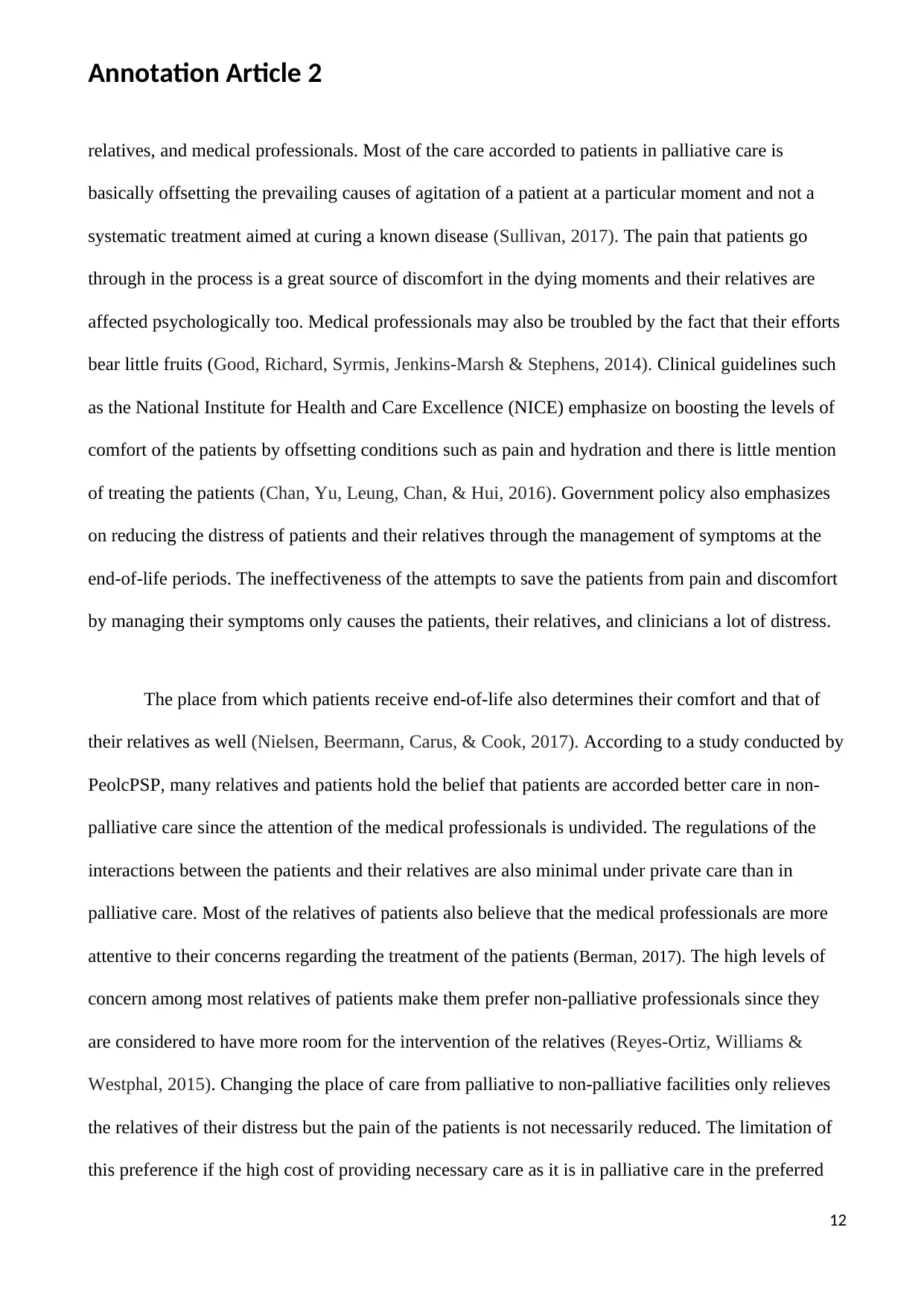
Annotation Article 2
relatives, and medical professionals. Most of the care accorded to patients in palliative care is
basically offsetting the prevailing causes of agitation of a patient at a particular moment and not a
systematic treatment aimed at curing a known disease (Sullivan, 2017). The pain that patients go
through in the process is a great source of discomfort in the dying moments and their relatives are
affected psychologically too. Medical professionals may also be troubled by the fact that their efforts
bear little fruits (Good, Richard, Syrmis, Jenkins-Marsh & Stephens, 2014). Clinical guidelines such
as the National Institute for Health and Care Excellence (NICE) emphasize on boosting the levels of
comfort of the patients by offsetting conditions such as pain and hydration and there is little mention
of treating the patients (Chan, Yu, Leung, Chan, & Hui, 2016). Government policy also emphasizes
on reducing the distress of patients and their relatives through the management of symptoms at the
end-of-life periods. The ineffectiveness of the attempts to save the patients from pain and discomfort
by managing their symptoms only causes the patients, their relatives, and clinicians a lot of distress.
The place from which patients receive end-of-life also determines their comfort and that of
their relatives as well (Nielsen, Beermann, Carus, & Cook, 2017). According to a study conducted by
PeolcPSP, many relatives and patients hold the belief that patients are accorded better care in non-
palliative care since the attention of the medical professionals is undivided. The regulations of the
interactions between the patients and their relatives are also minimal under private care than in
palliative care. Most of the relatives of patients also believe that the medical professionals are more
attentive to their concerns regarding the treatment of the patients (Berman, 2017). The high levels of
concern among most relatives of patients make them prefer non-palliative professionals since they
are considered to have more room for the intervention of the relatives (Reyes-Ortiz, Williams &
Westphal, 2015). Changing the place of care from palliative to non-palliative facilities only relieves
the relatives of their distress but the pain of the patients is not necessarily reduced. The limitation of
this preference if the high cost of providing necessary care as it is in palliative care in the preferred
12
relatives, and medical professionals. Most of the care accorded to patients in palliative care is
basically offsetting the prevailing causes of agitation of a patient at a particular moment and not a
systematic treatment aimed at curing a known disease (Sullivan, 2017). The pain that patients go
through in the process is a great source of discomfort in the dying moments and their relatives are
affected psychologically too. Medical professionals may also be troubled by the fact that their efforts
bear little fruits (Good, Richard, Syrmis, Jenkins-Marsh & Stephens, 2014). Clinical guidelines such
as the National Institute for Health and Care Excellence (NICE) emphasize on boosting the levels of
comfort of the patients by offsetting conditions such as pain and hydration and there is little mention
of treating the patients (Chan, Yu, Leung, Chan, & Hui, 2016). Government policy also emphasizes
on reducing the distress of patients and their relatives through the management of symptoms at the
end-of-life periods. The ineffectiveness of the attempts to save the patients from pain and discomfort
by managing their symptoms only causes the patients, their relatives, and clinicians a lot of distress.
The place from which patients receive end-of-life also determines their comfort and that of
their relatives as well (Nielsen, Beermann, Carus, & Cook, 2017). According to a study conducted by
PeolcPSP, many relatives and patients hold the belief that patients are accorded better care in non-
palliative care since the attention of the medical professionals is undivided. The regulations of the
interactions between the patients and their relatives are also minimal under private care than in
palliative care. Most of the relatives of patients also believe that the medical professionals are more
attentive to their concerns regarding the treatment of the patients (Berman, 2017). The high levels of
concern among most relatives of patients make them prefer non-palliative professionals since they
are considered to have more room for the intervention of the relatives (Reyes-Ortiz, Williams &
Westphal, 2015). Changing the place of care from palliative to non-palliative facilities only relieves
the relatives of their distress but the pain of the patients is not necessarily reduced. The limitation of
this preference if the high cost of providing necessary care as it is in palliative care in the preferred
12
⊘ This is a preview!⊘
Do you want full access?
Subscribe today to unlock all pages.

Trusted by 1+ million students worldwide
1 out of 16
Related Documents
Your All-in-One AI-Powered Toolkit for Academic Success.
+13062052269
info@desklib.com
Available 24*7 on WhatsApp / Email
![[object Object]](/_next/static/media/star-bottom.7253800d.svg)
Unlock your academic potential
Copyright © 2020–2025 A2Z Services. All Rights Reserved. Developed and managed by ZUCOL.





